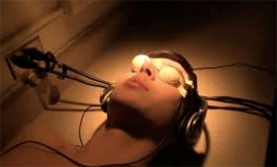
In parapsychology, the ganzfeld is a type of experiment that has proved to be an effective way to demonstrate the presence of ESP in the laboratory. This article describes the principle behind the method, the history of its development, and controversies over the claimed results.
- Overview
- History of the Ganzfeld
- Honorton and Hyman Meta-Analyses
- Joint Communiqué
- Sargent Controversy
- Bem and Honorton PRL Publication
- Wiseman and Milton Controversy
- Defining the Standard Ganzfeld
- Towards the Resolution of the Replication Issue?
- Are Ganzfeld Critiques Well-Founded?
- Experimenter Effects
- Theory Development
- Future Work
- Literature
- Endnotes
Overview
The ganzfeld is often regarded as the flagship of experimental parapsychology. It is a simple means of reproducing spontaneous psi (psychic) experiences in the laboratory, where controls can be applied to eliminate normal explanations. This makes it the main candidate for a repeatable (replicable) psi experiment – a reliable means of producing psi in the laboratory. Moreover, the level of success (effect size) is often sufficient to indicate that psi is not just a statistical anomaly but has content that is psychologically meaningful.
The ganzfeld, a German term meaning ‘whole field’, appears to achieve these criteria because it is an effective means of facilitating internal imagery. It does so by reducing stimulation to the brain from sight and hearing to a pleasant but minimal level, typically by immersion in a warm red light diffused by translucent hemispheres (often split halves of ping-pong balls) placed over the eyes and a relaxing rhythmic sound fed through headphones. For the latter, sea shore sound is favoured, but white noise (random frequencies) and pink noise (with the higher frequencies removed) is sometimes preferred.
The effect of lack of structure in this homogenous field is to stimulate the brain to replace ordinary sensory stimulation with internal imagery. For this reason the ganzfeld is regarded as a ready means of providing access to internal attention states.1 The state varies in terms of how much sleep-onset imagery and fantasy imagery an individual may experience. An EEG study found that the ganzfeld state generally has more alpha frequency than the pure sleep-onset (hypnagogic) period, and is therefore best described as a hypnagoid state – meaning that it is not a single pure state but rather one with varying characteristics of wakefulness, fantasy and sleep-onset.2
In principle, the ganzfeld could be used to study a variety of psychological processes in altered states, such as creativity in problem-solving. In practice, it has almost exclusively been used to study the perceptual characteristics of the imagery and to further the goals of psi-research.
The ganzfeld was first developed in a form which could be applied to the study of psi phenomena by three researchers: Charles Honorton, William Braud, and Adrian Parker, acting independently between 1974 and 1975.3 The following description, published by Honorton and Daryl Bem in 1994, describes the main elements:
The receiver is placed in a reclining chair in an acoustically isolated room. Translucent ping-pong ball halves are taped over the eyes and headphones are placed over the ears; a red floodlight directed toward the eyes produces an undifferentiated visual field, and white noise played through the headphones produces an analogous auditory field. It is this homogeneous perceptual environment that is called the Ganzfeld (‘total field’). To reduce internal somatic ‘noise,’ the receiver typically also undergoes a series of progressive relaxation exercises at the beginning of the ganzfeld period. The sender is sequestered in a separate acoustically isolated room, and a visual stimulus (art print, photograph, or brief videotaped sequence) is randomly selected from a large pool of such stimuli to serve as the target for the session. While the sender concentrates on the target, the receiver provides a continuous verbal report of his or her ongoing imagery and mentation, usually for about 30 minutes. At the completion of the ganzfeld period, the receiver is presented with several stimuli (usually four) and, without knowing which stimulus was the target, is asked to rate the degree to which each matches the imagery and mentation experienced during the ganzfeld period. If the receiver assigns the highest rating to the target stimulus, it is scored a hit.4
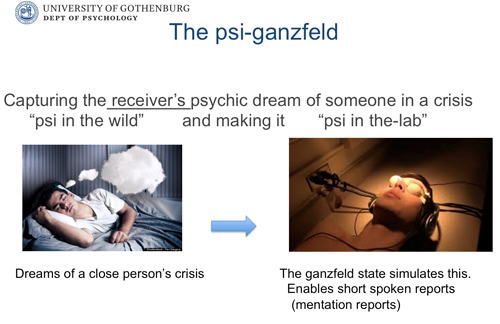
It is estimated that more than a hundred psi-ganzfeld studies have been reported. The ganzfeld has come to represent parapsychology's claim to have produced a repeatable experiment, whereby psi or ESP from real-life (psi-in-the wild) can occur under laboratory-controlled conditions. This claim is disputed by critics sceptical of psi’s existence, making it the centre of one of the longest and most intensive debates in natural science.
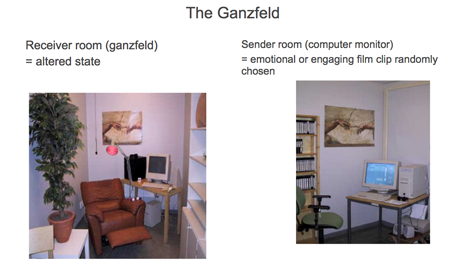
The rationale behind the use of the ganzfeld for psi research is that the technique simulates in the lab many of the conditions that appear to be necessary – if not sufficient – for psi to occur in ordinary life.
Spontaneous case studies of telepathy suggest that the receiver is most often in an altered state, while the sender is experiencing some form of emotional crisis.5 The ganzfeld equipment is used to produce the altered state in the receiver while emotional engagement is enabled by getting the receiver to focus on target material, with the intention of communicating its context to the receiver. Initially, art pictures and transparencies were used as target material, giving way later to film clips of unusual or emotionally arousing events.
History of the Ganzfeld
The ganzfeld had literally a palatial beginning during the early 1930s, as a blank screen on the wall of the Berlin City Palace. The procedure was at that time used by gestalt psychologists to demonstrate how imagery is formed as whole pictures or ‘gestalts’ – not built up from small sensory fragments, as other theories would then have suggested. Wolfgang Metzger, a leader of the gestalt movement in psychology, was in 1930 the first to use the word ‘ganzfeld’ to describe this means of projecting internal images onto the field of vision.6 Interest in the ganzfeld seems then to have ceased until the 1950s. Like the palace itself – which was first demolished then replaced, and again demolished before finally being rebuilt in its original form – the ganzfeld has gone through several transformations.7
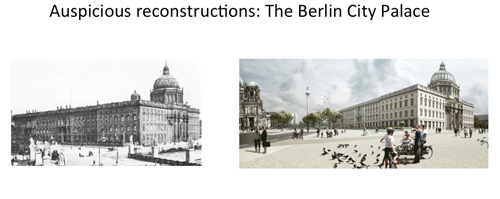
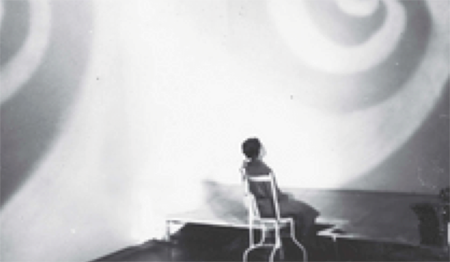
In 1951, the use of halved ping-pong balls replaced the blank wall as a means to create the homogenous field. The results were impressive: nearly all the participants in this study reported hallucinatory images.8 By 1964, as part of the upsurge in interest in dream states, the ganzfeld was starting to be used to study how exposure to an emotionally-loaded film would influence sleep-onset imagery, and later dream imagery. The distinctive features of the modern ganzfeld were now added. White noise was supplied through earphones and participants were required to give an ongoing account of what they were experiencing as this happened.9
Although this work was based on a small case study, it demonstrated clearly that the feelings and associations that occurred at the onset of sleep, as represented in hypnagogic imagery, related to the film content. Charles Tart, a pioneer in altered-states research, included this report in a book of readings later to become a classic called Altered States.10 This work inspired Braud, Honorton and Parker, each working independently, to adapt and apply the emerging technology to psi-research.
This initial design, based on the use of static images, held for the next decade. Important later modifications included the shift to emotionally-loaded film clips and the participation of an individual not otherwise involved in the experiment to carry out the ranking (blind judging).
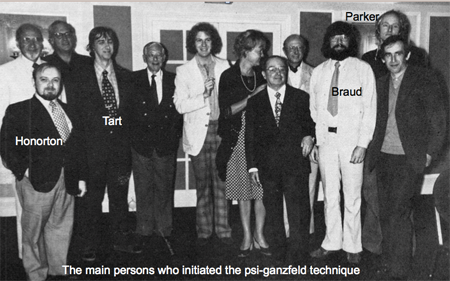
Honorton and Hyman Meta-Analyses
By 1982, 47 ganzfeld studies had been carried out, sufficient to enable two meta-analyses to be reported. Meta-analysis brings all the existing studies together with the aim of statistically identifying the common (non-chance) trends in the collective data. These analyses, one by the parapsychologist Charles Honorton and one by Ray Hyman, an academic psychologist and sceptic who had started to take a close interest in psi research, were presented in that year at the joint centenary conference of the Society for Psychical Research and the 25th Annual Convention of Parapsychological Association.11
Honorton had supplied Hyman with all the reported ganzfeld experiments up to that time (initially 42 reports, five more were added later by Parker and Wiklund). Most of the studies were claimed by Honorton to be statistically successful, having consistently obtained more hits than the 25% chance level. Over the initial 42 studies he claimed a 55% hit rate. However, the studies analysed the results in diverse ways; also, many were small in size. These characteristics led Hyman to suspect the data had been ‘massaged’ to give the best results, and that exploratory studies that turned out to be successful had been upgraded to the status of main studies. Moreover, the smaller studies tended to give better results, suggesting to Hyman that they had ended up being designated ‘studies’ as soon as chance results had been exceeded – a design flaw known as ‘optional stopping’.
Hyman also raised the possibility of ‘sensory cuing’: for instance, any visible marks on the target picture caused by handling it might enable it to be distinguished from the decoy non-targets with which it was being compared, and which had not been handled. Such cues could be eliminated by using a duplicate target image. To further eliminate any possibility of the identity of the target being given away, the order of targets and decoy target pictures needed to be randomized when they were presented for judging.
Another potential flaw noted by Hyman was the ‘file drawer effect’: failure to publish unsuccessful studies could skew the result of the meta-analysis, since these would not have been taken into account. Hyman estimated that there could have been eighty studies rather than the 47 he received.
Hyman re-calculated the result as, at best, a 33% hit rate – still statistically highly significant. But the problem remained that many studies were potentially faulty.
At this exchange was taking place, Adrian Parker and Nils Wiklund went systematically through all the ganzfeld studies they could find – a total of 49 published reports. They found only a handful that were free of major potential flaws of the kind Hyman had noted.12
One of the first issues to be resolved was that of ‘data massage’ or multiple analysis. In the ganzfeld, success could be identified by the target being correctly picked in preference to the non-targets (a ‘direct hit’). This would be most effective measure if ESP is an all-or-nothing process. But if information is partially conveyed, then other measures might be preferred: the sum of rankings given to targets compared with the decoys, or by rating the closeness of target content to the recalled imagery. This issue was never entirely resolved. However, Honorton decided to keep direct hits as the measure, on the pragmatic basis that it was the most commonly used, and it has become the conventional method.13
Hyman’s and Honorton’s meta-analyses were published in the 1985 issue of the Journal of Parapsychology.14 Honorton found 28 studies that used direct hits as the measure, and of these twelve were statistically significant. When combined in the meta-analysis, these studies were enormously significant with a Stouffer z of 6.60. Unlike Hyman, Honorton found no relation between sample size and significance.
Honorton then introduced a quality evaluation, identifying the number of potential flaws in each study, and again found no relation between quality and outcome. Here too, Hyman disagreed. (The problem was later avoided by the quality rating being made by persons who were blind as to the outcome of the studies.)
Finally, with regard to the file drawer problem, Honorton established that as many as 435 failed studies would have had to be overlooked in order to dilute the meta-analysis to the point of insignificance.
What happened next is almost unique in psychological science: an active and constructive dialogue between proponents and sceptics.
Joint Communiqué
After much discussion and four draft agreements, Hyman and Honorton finally agreed on a joint statement, as follows:
‘There is an overall significant effect that cannot be reasonably explained by selective reporting or multiple analysis. We continue to differ over the degree to which the effect constitutes evidence for psi, but we agree the final version awaits the outcome of future experiments conducted by a broader range of investigators and according to more stringent standards'.15
The protagonists also agreed on a set of methodological improvements, such as the use of direct hits, the randomization of targets for judging, and the implementation of security precautions – all of which became the gold standard for future ganzfeld experiments.
Sadly, the promise of continued collaboration was not fulfilled. In 1987, the US National Research Council (NRC) commissioned an investigation of various techniques that US Army was interested in, one of which was the ganzfeld. Hyman, as head of the investigative committee, wrote a dismissive evaluation, to the effect that ganzfeld did not present any evidence for psi. The final NRC report even censored the findings of one of the leading research psychologists of the era, Robert Rosenthal, which contracted Hyman's conclusion. This was perceived by many parapsychologists as disingenuous and created a mistrust that continues to reverberate.16
Sargent Controversy
Carl Sargent was one of the most successful ganzfeld researchers of the 1980s. His and his co-workers’ findings formed an important part of the early ganzfeld data analysed by Hyman and by Honorton. That it was carried out at Cambridge University gave it political importance.
However, doubts concerning the validity of Sargent's claims of success were voiced by Susan Blackmore, a psychologist then based at Bristol University who had herself previously carried out psi research but was emerging as a leading sceptic. In 1979 she visited Sargent’s laboratory at Cambridge, and four years later declared reservations about his work.17 In 1987, eight years after her visit, she published a detailed article describing her misgivings. The article abstract states:
I observed 13 sessions, of which six were direct hits. I considered whether the results might be accounted for by sensory leakage, experimental error, cheating or psi. I made observations of the sessions to test these hypotheses. The experimental design effectively ruled out sensory leakage. However, I observed several errors in the way the protocol was observed, Most of these occurred in the cumbersome randomization procedure. It was not clear how these errors came about. Their origin might have been clarified by either (a) a statement from Sargent or his colleagues, or (b) by reanalyses of the raw data. However neither has been made available. Sargent’s nine ganzfeld studies form a considerable portion of the total ganzfeld database. In view of Sargent’s unwillingness to explain the errors found, or to make his data available to other researchers, I suggest that these results should be viewed with caution.
Blackmore described how, on her own initiative and without Sargent's consent, she opened some of the envelopes and discovered they did not contain cards with the appropriate (randomly) selected code for the target pictures – a break in protocol. This irregularity could have been an accidental error, but it could also have been a fraudulent means of producing significant results. At least one other irregularity observed by Blackmore was the presence of Sargent with the subject during the judging stage, which could have allowed him to influence the subject’s selection of the target.
Sargent gave a scathing rebuttal to Blackmore’s accusations, but refused to co-operate in any further investigation and eventually withdrew from the field of psi research altogether.18 Although the issue of fraud remains unresolved in this case, it is clear that these experiments were not run as they should have been.
At that time, the experiments carried out by Honorton and Sargent accounted for half of the significant studies using the direct hits measure. Honorton emphasised that the remaining investigatory teams still reached a high level of significance.19 However, the studies carried out by Sargent and co-workers were judged to be among the top five in terms of being free from potentially major flaws in the review of 49 experiments by Parker and Wiklund.20 Once the Sargent work was eliminated, nearly all the remaining studies at that time had major potential flaws.
Bem and Honorton PRL Publication
Vulnerability to fraud and flaws was greatly reduced by a procedure known as the automatic ganzfeld, or autoganzfeld, that was subsequently developed by Honorton and colleagues at the Psychophysical Research Laboratory (PRL), a parapsychological research organisation founded in 1979 in Princeton, New Jersey, of which he was director.21 This technique used a computer to control the sequences and outcomes, strictly following the requirements stipulated in the Hyman-Honorton communiqué. With the help of Daryl Bem, a widely respected social psychologist, the findings were published in a leading scientific journal, the Psychological Bulletin,22 which ever since has continued to host discussions as to whether or not the ganzfeld provides a repeatable ESP experiment. These efforts have been carried on in the absence of Honorton, who died in 1994 aged 46, just nine days prior to the acceptance of the paper for publication.
Eleven further post-communiqué studies had been conducted by Honorton and co-workers before the loss of funding forced the closure of the PRL. It was at this time that dynamic targets in the form of short film-clips began to replace the use of static art pictures. This gave a combined result of 106 hits in 329 sessions, a hit rate of 34%, well above the chance rate of 25% – a highly significant result.
At this time, Bem and Honorton started to use a new statistic called effect size as a means to assess the strength of the phenomenon being studied. A strong phenomenon, unlike a weak one, would require few trials to reach statistical significance. The effect size they were achieving, close to 10% above chance expectancy, was classed as ‘medium’, meaning it could be noticed simply by looking at the data over a sufficient number of trials. The critical question of how many trials are needed in a study to produce a noticeable effect introduces the concept of the power of detecting an effect: even a 10% level would not be considered a success unless a hundred trials were carried out, and even then the odds of achieving significance would be no better than 50-50.
The PRL work was pioneering in one further respect, in that it turned away from the common practice of using psychology students as subjects for experiments. For Bem and Honorton, random college sophomores enrolled in an introductory psychology course ‘do not constitute the optimal subject pool’.23 Their recipe for success was to choose participants who had personal experience of psi, who practised meditation, and who achieved high scores on personality factors such as sensitivity to feeling and perception, and extraversion.
Parapsychologists might have thought this would settle the matter, establishing ganzfeld as a replicable method of producing ESP in the laboratory. However their chief critic, psychologist Ray Hyman, was still not prepared to concede this. He argued that the success achieved in PRL experiments was limited to those using the new dynamic targets, while those using static targets gave chance results, meaning that the PRL work could not be considered to have replicated the earlier successes.24
Defending the change in protocol, Adrian Parker pointed out the need to take advantage of new digital technologies as a means to maintain participant enthusiasm: previous research in mainstream psychology had already indicated that the ganzfeld works best with the use of arousing film clips.25 They further noted that some of the original successful ganzfeld studies had used slide reels, in which the sender was exposed not to a single image, but to a succession of images – half-way to being a dynamic target.
Hyman further argued that a bias might have been present in the choice of targets, since people are known to prefer certain images over others, such as water scenes for instance. This might bring about an apparently significant number hit by chance correspondence. However, Hyman’s critics pointed out that such bias works in different directions, and should balance out in a long series of trials.
A more pertinent problem highlighted by Hyman had been raised years earlier,26 and remains persistent today. Although the PRL series used eight different experimenters, Hyman regarded the series as one large experiment carried out in a single laboratory, directed by one research leader. He asserted the PRL work should therefore be considered not as replications of earlier work but as a new starting point, and that new replications were needed to establish the psi effect as real and repeatable.
Certainly, Honorton’s meta-analysis had shown that the results of the earlier work did not depend on one or two laboratories: six out of ten had produced significant results. However, as noted above, these studies were not of the same quality as the autoganzfeld studies, and for Hyman they did not count. A further negative factor was the inclusion of the dubious Sargent work.
Wiseman and Milton Controversy
Despite Hyman's objections, for a period of five years it seemed that parapsychology had won some tacit acceptance. Although there was no stampede to replicate findings, some research funding was forthcoming.27 The situation changed again when, in 1999, Julie Milton and Richard Wiseman published in the Psychological Bulletin a new meta-analysis of thirty studies reported between 1987 to 1997. This showed a near-zero effect size and an overall statistic that was on a non-significant (although a later re-analysis suggested it just reached the level of significance). They concluded: ‘The ganzfeld technique does not at present offer a replicable method for producing ESP in the laboratory’.28
Critics immediately pointed out major problems in the authors’ selection of studies. The largest study, which was unsuccessful, had departed from the standard ganzfeld protocol by employing musical targets instead of the customary visual ones.29 The authors omitted the most successful of Parker's ganzfeld studies;30 also they failed to take account of a highly significant study by Kathy Dalton that was about to be reported, on the grounds that this was an ‘outlier’ (although some parapsychologists have taken a similar view: see below Towards the Resolution of the Replication Issue?).
Moreover, as Storm and Ertel showed, the variance for Milton and Wiseman's thirty studies clearly exceeded chance, meaning that there was a negative effect – sometimes called ‘psi-missing’ – as well as a positive one. In addition, had the older studies been added this would have increased the statistical significance to enormous levels.31 However, Milton and Wiseman argued that the only studies that counted as replications were those carried out after the PRL studies, which, as did Hyman, they saw as setting the standard for future replications.32
Following this critique, the focus in fact shifted to the post-PRL work. Updates were reported by Milton who added nine new studies33 and by Richard Broughton and John Palmer.34 These studies collectively reached significance, but the hit rate at 30% remained below the 34% achieved in the PRL work, while the effect size was still greatly reduced.
Parapsychologists continue to argue against these meta-analyses on the grounds that they included studies that departed in major respects from the standard ganzfeld protocol. Besides the use in one of musical targets,35 noted above, another study adopted a serial ganzfeld method that employed four target film clips per session, in order to maximise any flood of psi that might occur .36
Defining the Standard Ganzfeld
The ganzfeld had become a victim of its own success: believing the effect had been demonstrated beyond doubt, some of those who used it preferred to explore new variations rather than keep repeating the same thing. But this had implications for the ganzfeld as a replicable experiment, since these new approaches did not always work. Clearly a standard needed to be defined in future research.
A general solution was to evaluate the post-PRL studies, which by now numbered forty (ten having been added to the thirty evaluated by Milton and Wiseman), on the degree to which they adhered to the standard. To rate the studies, students were recruited who had no prior knowledge of their outcomes, ensuring they were rated blindly.37
As an objective definition of the ganzfeld procedure, the authors simply used the description provided in the original PRL report by Bem and Honorton (see Overview, above).38 The students carrying out the rating were also told to treat as standard the use of artistic or ‘creative’ persons, those reporting previous psi experiences, and those who routinely practised a mental discipline such as mediation.These selection criteria were after all considered vital components of the PRL experiment.
By using this method the outcome was shown to correlate significantly with the degree to which the replication studies adhered to the standard procedure. Moreover, when this was the case the effect was highly significant: the hit rate of 31% is somewhat reduced compared with earlier studies, but falls within the expected variation for the hit rates with these effect sizes. Also, the size of the effect obtained was comparable with those of the earlier studies. In short, the new standard studies were found to have replicated the PRL findings.
In 2003, Palmer reviewed the three databases (from the pre-PRL, PRL, and post PRL studies) for the Journal of Consciousness Studies.
It seems to me that all three databases have provided overall significant evidence of ESP and fit reasonably well within each other’s confidence intervals. This is an impressive rate of stability that clearly cannot be attributed to just a handful of investigators, but at the same time, investigator differences do seem to play some role. Furthermore, the successful investigators all come from a fairly narrowly defined population of experimental parapsychologists who may not be very representative of scientific researchers generally.39
This prescient comment drew attention to what has become known as the experimenter effect, the source of much controversy in parapsychology (see below).
Towards the Resolution of the Replication Issue?
A further update with regard to steps taken to resolve replication issues appeared in 2010, again in the Psychological Bulletin. Here, Storm and his co-workers extended their earlier analysis of post-1997 studies to 2008, finding a further thirty studies.40 This time they decided to exclude the highly successful Dalton study (mentioned above), since this was regarded as an ‘outlier’ for its unusually high hit rate of 47%. The aim was to make the distribution of scores follow the normal variation recommended for statistical evaluation, and thus provide maximum confidence in the final result. This meta-analysis concluded that nine of the 29 studies were independently significant and established once again a highly significant hit rate of 32%, an effect that would have required as many as 95 mainly below-chance studies to eliminate.
An important feature of this analysis was the introduction of quality of the study as an operationally defined measure, a checklist of issues such as target randomization, the target’s presentation for judgment with the decoys, blind judging, sensory shielding, and security aspects. When this measure was applied to the thirty ganzfeld studies no correlation was found with effect sizes, suggesting that significant results could not be explained as an artefact of poor experimental design.
Nor did the new data confirm Hyman's earlier critique that the effect size of later replication attempts was greatly diminished. When the later studies were compared to their older, larger data-base of 79 studies) no essential difference could be discovered. When all the studies were collected, and ‘normalized’ by excluding six untypical outliers, the remaining 102 studies gave an enormous statistically significant effect (Stouffer Z: 8.13, p 10-16; effect size .135). ‘File drawer’ explanations could be dismissed, since as many as 2,414 unpublished non-significant studies would need to be unearthed for the result to be exposed as non-significant – a clearly impossible number given the small scale of parapsychological research. The database also confirmed the earlier PRL finding that selected participants were more likely to succeed.
Ray Hyman was quick to object to an analysis carried out on the whole database, with all its shortcomings, as opposed to one based on the later (post-communiqué or post-PRL) studies that had been designed to overcome them. But now he went further, repeating the criticism that almost all the above-chance hitting came from four experimenters who contributed half the studies to the original Pre-PRL database.41
By contrast, Storm et al maintain they found no significant experimenter or laboratory differences in the new data. They found seven successful experimenters – Morris, Parker, Parra, Roe, Roney-Dougal, Tressoldi and Wezelman – each of whom contributed two or more studies to a database consisting of thirty post-PRL ganzfeld studies and an additional sixteen ‘noise reduction studies’ in dreaming, hypnosis, meditation and relaxation.
However, the addition of non-ganzfeld data here confuses matters. The fact remains that the ganzfeld appears not work for most researchers, suggesting that the ganzfeld has not fulfilled its earlier promise as a procedure invulnerable to experimenter effects.
In his most recent assessment Hyman went so far as to assert that meta-analysis is in any case insufficient for the purpose of scientific acceptance; a theory is needed – a tactic that does not merely move the goal posts, but obscures the goal altogether.42
In 2013, Bryan Williams reported a meta-analysis based on 59 studies (thirty from Milton and Wiseman and 29 additional ones from the Storm et al. 2010 study).43 Here the focus was entirely on the post-PRL autoganzfeld studies, as Hyman had insisted. This confirmed the earlier results, with a hit rate in the order of 30-32% depending on whether or not the highly successful Dalton study is included. In short, the correct target film clip was identified correctly close to one in three times whereas chance guessing would make it one in four. Williams found that replication of the PRL work had now been attempted by fifteen laboratories, of which more than half had produced a similar hit rate. His verdict was that ‘the psi ganzfeld effect has indeed been replicated by "a broader range of investigators" under stringent standards'.44
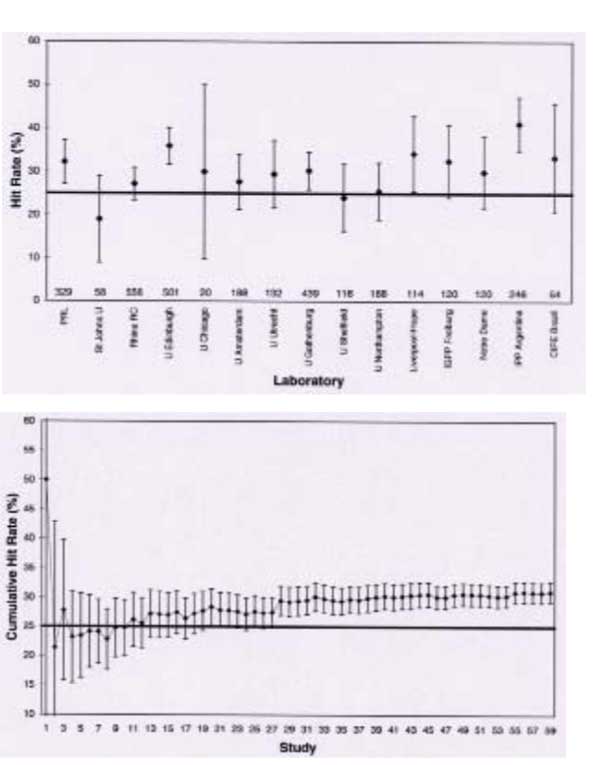
In recent years, the replication issues that have plagued parapsychology have started to appear also in psychology. As many as two-thirds of the results previously regarded as established have failed to replicate because of flawed methodology such as multiple analysis of results, faulty statistics, file drawer problems, fraud, and biased selection of data. One conclusion is that parapsychology might be given credit for having identified and tackled these problems earlier, strengthening confidence in its findings.
Another viewpoint is that this merely reinforces doubts regarding claims that the ganzfeld is a successful replicable methodology. In 2016, parapsychologists Bierman, Spottiswoode and Bijl created a computerized simulation using ‘worse case scenarios’ of fraud and selection of data, to see if these would bring the distribution of ganzfeld scores near to chance level.45 The worst-case result they found was 27%, which is only slightly statistically significant, and well within the 5% margin of error.
However, other parapsychologists rejected this conclusion. John Palmer criticized it as being entirely a speculative exercise without foundation,46 and tantamount to shooting wild, given that the history of the ganzfeld has been concerned with eliminating just these sources of error. If Bierman et al’s estimate is assumed to be true, for argument’s sake, such a small effect size would mean that parapsychologists would have in future to test over seven hundred participants to have a good (80%) chance of obtaining significant results – an impossibility considering their limited resources.
A proposal that has received considerable support in parapsychology is that future experiments be registered in advance, giving full details of how the data are to be analysed. Such a register was established in 2013 by the Koestler Unit at Edinburgh University. However, so far only one ganzfeld study has been registered – a reflection of the scarcity of funding for research.
Are Ganzfeld Critiques Well-Founded?
It seems clear that the later studies have fulfilled the requirements originally agreed by Hyman and Honorton. Few parapsychologists accept his criticism that the use of film clips departs from the original methodology using static images, and is therefore not a true replication, since the same process is at work. Hyman’s recent concern about the limitations of meta-analysis may have substance in itself, but surely represents an unacceptable shift of stance with regard to the joint communiqué.
Another criticism sometimes directed at the ganzfeld data is that the level of significance does not increase with the number of trials or participants, as usually happens in psychology and medicine. For instance the anti-coagulation effect of aspirin (preventive for stroke) was so small that it could only be shown by many thousands of trials.
Experimenter Effects
In fact the later analyses by Baptisa et al and by Storm et al suggest that psi behaves in this lawful way. However, in order to achieve this the authors had to remove so-called outliers – in particular the extremely successful 1977 study reported by Dalton47 which reached the record hit rate of 47%. This may appropriately concede to Hyman an important point regarding experimenter effects. From the meta-analyses reviewed above it is evident that the psi-ganzfeld does not work for most experimenters while for some it works extraordinary well. Removing outliers in the interest of making a more balanced or homogenous distribution may be fully justified for statistical purposes but it hides something fundamental about how psi works. It also seems somewhat arbitrary to exclude the Dalton study when it is considered that Parker Study 4 also gave 47%48 and Wezelman and co-workers obtained 44%.49 Effect sizes are also not so dissimilar.
An original objective in using ganzfeld technology was to avoid any effect on the outcome caused by the experimenter’s personal charisma. But this may not be achievable in practice, nor is it necessarily even desirable. Views about the placebo effect are being revised in medicine, where it is now seen not merely as obscuring the effect of drugs but as a vital part of treatment in its own right. Similarly, the role played by the experimenter may be seen not merely as an obstruction to be guarded against, but as an element necessary for the experiment's success.
To select for successful experimenters as well as successful participants would arguably be not just aberrant, it would be abhorrent to the objective model of science and psychology that Hyman advocates. Another view is that taking the experimenter into account recognizes the complexity of the phenomena; it does not mean abandoning science.
Almost no work has been done to understand what characterizes successful experimenters.50 However, a current review indicates that they have often had psychic experiences of their own, and, perhaps even more crucial, they tend to perform well in their own ganzfeld experiments51 (striking examples include Dalton and Parker).52 Until recently, this has been something of a taboo topic, perhaps because of the natural concern of parapsychologists not to differentiate their work from other science.
Theory Development
In terms of theory development, the ganzfeld offers a unique and hitherto unexploited opportunity. Most parapsychology experiments have low effect sizes, whereas the ganzfeld has the highest effect of the major techniques.53 Other methods of studying psi or ESP may require fewer man-hours but the effect is usually weak, meaning that most scores are at chance level. Attempts are then made to relate or correlate these largely chance scores to psychological variables – which themselves are more often than not weak measures of what they are said to measure. In effect we are relating one set of chance scores to another set. By using the ganzfeld we can get purer measures of psi.
One approach is to dispense with psychological tests and use the ganzfeld in a qualitative way, in order to gain insight into the process of psi as it enters consciousness. Honorton and Dalton individually provided striking examples of receivers accurately describing film-clips viewed by the sender, but they could not be sure that these correspondences matched in real time.
The real-time autoganzfeld was therefore devised, with a timing feature introduced that synchronised mentation reports with film clips.54 This enables the receiver to record the imagery he or she is experiencing as they happen, via a microphone directly into the computer. The computer program superimposes these voice recordings (mentation reports) in real time onto both the target film clip and the three decoys. The judge (often the receiver) can then listen to the recording and decide which is the best match. The technique also enables the sender to listen to the receiver's voice from the ganzfeld room via a one way microphone communication to earphones or to speakers, adding considerable excitement to the procedure. The success of this technique seems now well-enough established to make it part of the gold standard for the future autoganzfeld research.55
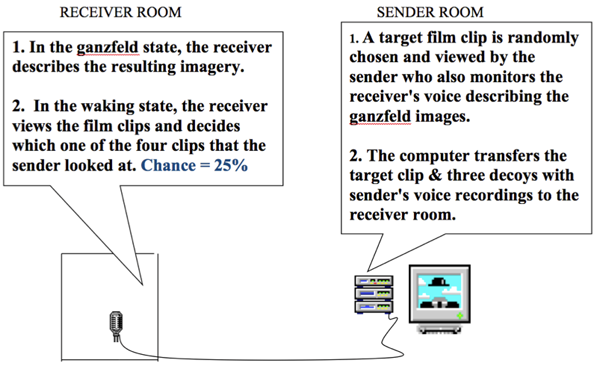
The striking nature of the real hits that were recorded using this methodology was questioned by critic Joakim Westerlund, whom Parker worked with.56 Westerlund artificially created seemingly impressive correspondences derived from both supposedly real hits and chance correspondences, finding that they were indistinguishable. To achieve this, Westerlund re-arranged recordings that belonged to an earlier experiment he had been involved in, and which had given significantly negative scores for the receivers’ assessments of hits. However, since the artificial matches were not compared to those from a successful ganzfeld, it was conceptually difficult to know what was responsible for the false hits. Also, the original experiment was carried out under stressful interpersonal conditions, which might explain the remarkable negative scoring. Whatever the case, the matches artificially found by Westerlund were unlike the specific matches found in long sequences of real time ganzfeld images, which can often be seen to closely follow diverse and sudden changes of content in the film clips, a characteristic of the best qualitative hits.57
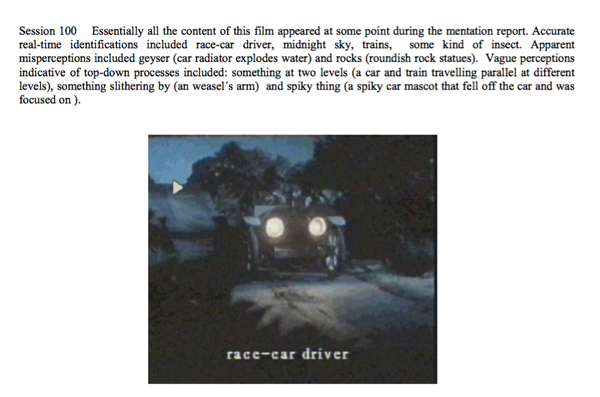
No major theories have evolved from this work as yet, but there are some hypotheses. One is that the real-time hits strongly suggest that images emerge into consciousness in a similar way as normal images do under less than optimal conditions. This means that sometimes they are very accurate, as for example in the imagery perceived in relation to the film clip of a race car driver.
On the other hand misperceptions sometimes occur, as happens also with normal vision. For example, when the film-clip shows a woman defending herself with a crooked stick, this stick appears to the receiver as a ‘boomerang’.
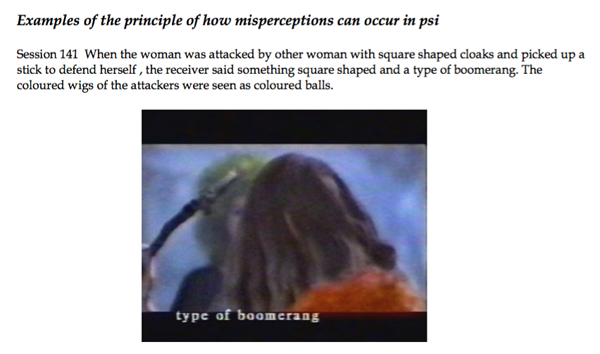
An early speculation is that the ganzfeld is successful, not because it is a specific altered state of consciousness but because it is a series of rapidly changing states, which allows extrasensory information to slip in.58
Theory development was the final hurdle that Hyman set for parapsychologists. While the aim of ganzfeld research should never be to satisfy the shifting demands of the critic, a workable methodology is prerequisite for learning something about the phenomena being studied and understanding its meaning. It seems clear that this, rather than more replications, should be the future priority.
Future Work
There have been initial attempts to look at the possible role of the sender and interpersonal factors in facilitating positive results with the ganzfeld. The sender does not appear to be crucial, but most of the research on interpersonal factors have either not obtained a strong psi effect or used an insufficiently large number of trials to reveal what is going on.59
Future work needs to consider the selection of appropriate participants as mandatory. The overall hit rate for the meta-analysis for the studies between 1997–2008 using selected participants was 40%, while those who used unselected participants obtained a mere 27% hit rate. Williams estimated from this that using selected participants would then require only 56 trials for an 80% chance of reaching statistical significance – far fewer than the one hundred or so required for a 32% hit rate.
As noted earlier, the odds of succeeding is called a power analysis and allows us to know just how many trials or participants are needed for the experiment to reach statistical significance. This obviously depends on the strength or effect size of the phenomena being studied; it is analogous to painting with concentrated paint rather than diluted paint, which would require many more layers – equivalent to trials or participants – to achieve the same result. By selecting potentially successful participants, the effect size can be shifted from slight to moderate. It has been calculated that, theoretically, the experiments could become so effective that replication rates of 80% can reached.60
Using the same participants over the course of several sessions may also be an option. When Parker and co-workers asked nine participants who had achieved good quality hits to return for a second session, four were able to repeat their success.61
Refining the way targets are selected may also be important. The evidence suggests that, while emotional targets give better results than neutral ones, even better results can be achieved by emotional targets that contain special relevance for the receiver.62
Adrian Parker
Literature
Baptista, J., Derakhshani, M., & Tressoldi, P. (2015). Explicit anomalous cognition: A review of the best evidence in ganzfeld, forced choice, remote viewing and dream studies. In Parapsychology: A Handbook for the 21st Century, ed. by E. Cardeña, J. Palmer, & D. Marcusson-Clavertz, 192-214. Jefferson, North Carolina, USA: McFarland.
Bem, D.J., & Honorton, C. (1994). Does psi exist? Replicable evidence for an anomalous process of information transfer. Psychological Bulletin 115/1, 4-18.
Bem, D.J., Palmer, J., & Broughton, R.S. (2001). Updating the ganzfeld database: A victim of its own success? Journal of Parapsychology 65/3, 207-18.
Bertini, M., Lewis, H., & Witkin, H. (1964). Some preliminary observations with an experimental procedure for the study of hypnagogic and related phenomena. Archivo di Psicologia Neurologia e Psychiatra 25, 493-534.
Bierman, D.J., Spottiswoode, J.P., & Bijl, A. (2016). Testing for questionable research practices in a meta-analysis: An example from experimental parapsychology. PLoS One (May 4) 11/5.
Blackmore, S. (1987). A report of a visit to Carl Sargent’s laboratory. Journal of the Society for Psychical Research 54/808,186-98.
Carter, C. (2012). Science and Psychic Phenomena: The Fall of the House of Skeptics. Rochester, Vermont, USA: Inner Traditions.
Dalton, K. (1997). Exploring the links: Creativity and psi in the ganzfeld. In Proceedings of Presented Papers, Parapsychological Association 40th Annual Convention, Brighton, UK, 7–10 August, 119-34.
Da Silva, F.E., Pilato, S., & Hiraoka, R. (2003). Ganzfeld vs. no Ganzfeld: An exploratory study of the effects of Ganzfeld conditions on ESP. In Proceedings of Presented Papers, Parapsychological Association 46th Annual Convention, Vancouver, Canada, 2–4 August, 31-48.
Hochberg, J.E., Triebel, W., & Seaman, G. (1951). Color adaptation under conditions of homogeneous visual stimulation (ganzfeld). Journal of Experimental Psychology 41/2, 153-59.
Honorton, C. (1977). Psi and internal attention states. In Handbook of Parapsychology, ed. by B.B. Wolman, 435-72. New York: Van Nostrand Reinhold.
Honorton, C. (1983). Response to Hyman's critique of psi ganzfeld studies. Research in Parapsychology 1982, ed. by W.G. Roll, J. Beloff, & R.A. White. Metuchen, New Jersey, USA: Scarecrow Press.
Honorton, C. (1985). Meta-analysis of ganzfeld research: A response to Hyman. Journal of Parapsychology 49/1, 51-91.
Honorton, C., Berger, R.E., Varvoglis, M.P., Quant, M., Derr, P., Schechter, E.I., & Ferrari, D.C. (1990). Psi communication in the ganzfeld: Experiments with an automated testing system and a comparison with a meta-analysis of earlier studies. Journal of Parapsychology 54/2, 99-139.
Hyman, R. (1983). Does the ganzfeld experiment answer the critic's objections? Research in Parapsychology 1982, ed. by W.G. Roll, J. Beloff, & R.A. White. Metuchen, New Jersey, USA: Scarecrow Press,
Hyman, R. (1985). The ganzfeld psi experiment: A critical appraisal. Journal of Parapsychology 49/1, 3-49.
Hyman, R. (1994). Anomaly or artifact? Comments on Bem & Honorton. Psychological Bulletin 115/1, 19-24.
Hyman, R. (2010). Meta-analysis that conceals more than it reveals: Comment on Storm et al. (2010). Psychological Bulletin 136/4, 486-90.
Hyman, R., & Honorton, C. (1986). A joint communiqué: The psi ganzfeld controversy. Journal of Parapsychology 50/4, 351-64.
Krippner, S., & Friedman, H.L. (eds.) (2010). Debating Psychical Experience: Human Potential or Human Illusion? Santa Barbara, California, USA: Praeger.
Metzger, W. (1930). Optische Untersuchungen am Ganzfeld. II: Zur Phanomenologie des homogenen Ganzfelds. Psychologische Forschung 13, 6-29.
Milton, J. (1999). Should ganzfeld research continue to be crucial in the search for a replicable psi effect? Part 1. Discussion paper and an introduction to an electronic mail discussion. Journal of Parapsychology 63/4, 309-33.
Milton, J., & Wiseman, R. (1999). Does psi exist? Lack of replication of an anomalous process of information transfer. Psychological Bulletin 125/4, 387-91.
Milton, J., & Wiseman, R. (2001). Does psi exist? Reply to Storm and Ertel (2001). Psychological Bulletin 127/3, 434-38.
Morris, R., Dalton, K., Delanoy, D., & Watt, C. (1995). Comparison of the sender/no sender in the Ganzfeld. In Proceedings of Presented Papers, Parapsychological Association 38th Annual Convention, Durham, NC, USA, 5–8 August, 244-59.
Palmer, J., & Broughton, R.S. (2000). An updated meta-analysis of post-PRL ESP ganzfeld experiments: The effect of standardness. In Proceedings of Presented Papers, Parapsychological Association 38th Annual Convention, Durham, NC, USA, 5–8 August, 224-40.
Palmer, J. (2003). ESP in the ganzfeld: Analysis of a debate. Journal of Consciousness Studies 10/6-7, 51-68.
Palmer, J. (2017) Editorial. Statistical issues in parapsychology: Hypothesis testing-plus an addenum on Bierman et al. (2016). Journal of Parapsychology 80/2, 141-45.
Parker, A. (1978). A holistic methodology in psi research. Parapsychology Review 9.
Parker, A. (1994). Eyeballing the ganzfeld. Symposium in Proceedings of Presented Papers, Parapsychological Association 37th Annual Convention, Amsterdam, Holland, 7–10 August.
Parker, A. (2000). A review of the Ganzfeld work at Gothenburg University. Journal of the Society for Psychical Research 64/858, 1-15.
Parker, A. (2001). The Ganzfeld: Suggested improvements of an apparently successful method of psi research. Paper presented at symposium on parapsychology at the 27th International Congress of Psychology, Stockholm, Sweden. European Journal of Parapsychology 16.
Parker, A. (2011). Review of Debating Psychical Experience: Human potential or human Illusion?, ed. by S. Krippner & H.L. Friedman. Journal of Parapsychology 75.
Parker, A., Frederiksen, A., & Johansson, H. (1997). Towards specifying the recipe for success with the Ganzfeld. European Journal of Parapsychology 13.
Parker, A., Grams, D., & Pettersson, C. (1998). Further variables to psi in the ganzfeld. Journal of Parapsychology 62, 31-37.
Parker, A., & Millar, B. (2014). Revealing psi secrets: Successful experimenters seem to succeed by using their own psi. Journal of Parapsychology 78/1, 39-55.
Parker, A., Persson, A., & Haller, A. (2000). Using qualitative Ganzfeld research for theory development: Top down processes in psi-mediation. Journal of the Society for Psychical Research 64.
Parker, A., & Westerlund, J. (1998). Giving the Ganzfeld an old and a new twist. in Proceedings of Presented Papers, Parapsychological Association 41st Annual Convention, Hallifax, Canada, 6–9 August.
Parker, A., & Wiklund, N. (1987). The Ganzfeld experiments: Towards an assessment. Journal of the Society for Psychical Research 54/809, 261-65.
Pérez-Navarro, J.M., & Guerra, X.M. (2012). An empirical evaluation of a set of recommendations for extrasensory perception experimental research. EJOP: Europe's Journal of Psychology 8/1.
Rhine, L.E. (1962). Psychological processes in ESP experiences. Part II: Dreams. Journal of Parapsychology 27, 172-99.
Sargent, C. (1987). Sceptical fairytales from Bristol. Journal of the Society for Psychical Research 54/808, 208-18.
Sherwood, S., Roe, C., Holt, N., & Wilson, S. (2005). Interpersonal psi – exploring the role of the experimenter and the experimental climate in a ganzfeld telepathy task. European Journal of Parapsychology 20, 150-72.
Smith, M. (2003). The psychology of the "psi-conducive" experimenter: Personality, attitudes towards psi, and personal psi experience. Journal of Parapsychology 67/1, 117-28.
Storm, L., & Ertel, S. (2001). Does psi exist? Milton and Wiseman’s (1999) meta-analysis of ganzfeld research. Psychological Bulletin 127, 424-33.
Storm, L., Tressoldi, P.E., & Di Risio, L. (2010). Meta-analysis of free-response studies, 1992–2008: Assessing the noise reduction model in parapsychology. Psychological Bulletin 136/4, 471-85.
Tart, C. (ed.) (1969). Altered States of Consciousness. New York: Anchor.
Wackermann, J., Pültz, P., & Allefeld, A. (2008). Ganzfeld-induced hallucinatory experience, its phenomenology and cerebral electrophysiology. Cortex, 44/10, 1364-78.
Westerlund, J., Parker, A., Dalkvist, J., & Hadlaczky, G. (2006). Remarkable correspondences between ganzfeld mentation and target content: a psychical or psychological effect? Journal of Parapsychology 70/1, 23-48.
Wezelman, R., Gerding, J.L.F., & Verhoeven, I. (1997). Eigensender ganzfeld psi: An experiment in practical philosophy. European Journal of Parapsychology 13, 28-39.
Williams, B.J. (2011). Revisiting the ganzfeld ESP debate: A basic review and assessment. Journal of Scientific Exploration 25/4, 639-61.
Willin, M.J. (1996). A ganzfeld experiment using musical targets. Journal of the Society for Psychical Research 61/842, 1-17.
Wright, D., & Parker, A. (2003). An attempt to improve ESP scores using the real time digital Ganzfeld technique. European Journal of Parapsychology 18, 65-72.
Endnotes
- 1. Honorton (1977).
- 2. Wackermann, Pültz, & Allefeld (2008).
- 3. Honorton (1985), 53; Bem & Honorton (1994), 5.
- 4. Bem & Honorton (1994), 5.
- 5. Rhine (1962).
- 6. Metzger (1930).
- 7. The Berlin Palace was demolished it 1950 by the German Democratic Republic who replaced it with a metallic looking structure called the Palace of the German Republic which was demolished in 2008. The new palace was rebuilt in 2016 to be closely identical to the original one.
- 8. Hochberg, Triebel, & Seaman (1951).
- 9. Bertini, Lewis, & Witkin (1964).
- 10. Tart (1969).
- 11. Hyman (1983).
- 12. Parker & Wiklund (1982), unpublished report cited in Parker & Wiklund (1987).
- 13. Honorton (1983).
- 14. Hyman (1985); Honorton (1985).
- 15. Hyman & Honorton (1986).
- 16. For differing accounts of the NRC controversy, see Carter (2012, 86-88) and Hyman in Krippner & Friedman (2010, 138-41).
- 17. Blackmore (1987).
- 18. Sargent (1987).
- 19. Honorton (1985), 60.
- 20. Parker & Wiklund (1987).
- 21. Honorton, Berger, Varvoglis, Quant, Derr, Schechter, & Ferrari (1990).
- 22. Bem & Honorton (1994).
- 23. Bem & Honorton (1994),14.
- 24. Hyman (1994).
- 25. Parker (2011).
- 26. Parker (1978).
- 27. It was at the end of this period that the Gothenburg University Psychical Research Unit received state funding for a research programme with the real time ganzfeld.
- 28. Milton & Wiseman (1999).
- 29. Willin (1996).
- 30. Parker, Grams, & Pettersson (1998).
- 31. Storm & Ertel (2001).
- 32. Milton & Wiseman (2001).
- 33. Milton (1999).
- 34. Palmer & Broughton (2000).
- 35. Willin (1996).
- 36. Parker & Westerlund (1998).
- 37. Bem, Palmer, & Broughton (2001).
- 38. Bem & Honorton (1994), 5.
- 39. Palmer (2003).
- 40. Storm, Tressoldi, & Di Risio (2010).
- 41. Hyman (2010).
- 42. Parker (2011).
- 43. Williams (2011).
- 44. Williams (2011), 654.
- 45. Bierman, Spottiswoode, & Bijl (2016).
- 46. Palmer (2017).
- 47. Dalton (1997).
- 48. Parker (2000).
- 49. Wezelman, Gerding, & Verhoeven (1997).
- 50. Smith (2003).
- 51. Parker & Millar (2014).
- 52. Parker, Persson, & Haller (2000).
- 53. Storm, Tressoldi, & Di Risio (2010), 477.
- 54. Parker (2001).
- 55. Wright & Parker (2003); da Silva, Pilato, & Hiraoka (2003); Pérez-Navarro & Guerra (2012).
- 56. Westerlund, Parker, Dalkvist, & Hadlaczky (2006).
- 57. Parker, Persson, & Haller (2000).
- 58. Parker (1994), 14.
- 59. Morris et al. (1995); Sherwood et al. (1995).
- 60. Baptista, Derakhshani, & Tressoldi (2015).
- 61. Parker, Frederiksen, & Johansson (1997), 21.
- 62. da Silva, Pilato, & Hiraoka (2003); Parker, Grams, & Pettersson (1998).

